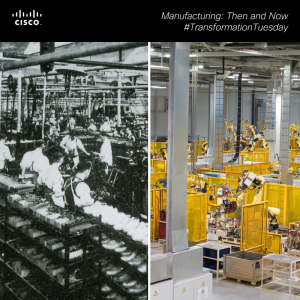 It’s interesting to think back to the times when a manufacturing job meant hard labor, a lack of automation and crowded plant floors. Flash forward to the manufacturers of today and the differences in productivity and efficiency are incredible. In a previous post, I mentioned that the misperception of the manufacturing industry is a dirty, assembly-line-type of work, too blue-collar to be both a dream job and provide a level of success that is ‘expected’ in today’s society. In reality, the manufacturing industry has experienced incredible transformation and is one of the most advanced industries today.
It’s interesting to think back to the times when a manufacturing job meant hard labor, a lack of automation and crowded plant floors. Flash forward to the manufacturers of today and the differences in productivity and efficiency are incredible. In a previous post, I mentioned that the misperception of the manufacturing industry is a dirty, assembly-line-type of work, too blue-collar to be both a dream job and provide a level of success that is ‘expected’ in today’s society. In reality, the manufacturing industry has experienced incredible transformation and is one of the most advanced industries today.
The U.S. manufacturing sector generates $1.7 trillion in value each year, but oddly enough in this time of high unemployment, it has more than 600,000 unfilled jobs. The push to innovate and change minds about the manufacturing industry should be at an all-time high. We need to encourage students at all education levels – elementary, intermediate, high school and college— to seize these opportunities and educate them on what a manufacturing job and career really looks like today. It’s not what it used to be.
Manufacturing Then
In the 1950s, long, tedious processes caused the industry to have a workforce that built itself on intense labor processes. The workforce had little-to-no education, a hardened skillset and a fluctuating pay rate. Not only were employees often disgruntled, they also worked in difficult, and often hazardous, environments day-in and day-out. Due to the unsteady and off-putting conditions, the industry saw a decline in employment interest. That is, until the industry underwent a positive transformation.
And Now
As technology advances, so does manufacturing. Today’s plant floor looks a lot different than it did 50 years ago. Machine automation replaced manual labor. The Internet connected our machines and increased plant-floor communications. The industry has seen substantial growth in productivity, efficiency and overall employee satisfaction.
A recent and relevant example of new technology that has the industry buzzing is 3D Printing. Because of its ability to quickly take design concepts and rapidly produce goods that can be sold as finished products, 3D printing is seen as one of the next “new things” for manufacturers. My only question is what’s next?
Technology advances continue to change the manufacturing industry for the better. These advances have created new types of manufacturing jobs that require more technical ability and critical thinking from employees who operate computer driven equipment, processes and environments. There are really good, well paid positions that need to be filled across the industry. This new, innovative workplace welcomes both millennials and the existing skilled workforce as manufacturers fill the jobs the momentum of the trillion-dollar business has left open.
The ball is in your court now. How are you helping change the perception of the manufacturing industry? Let’s make a difference. In my next post, I will discuss what influencers and educators can do to help the future generations of the manufacturing workforce.
As technology advances, so does manufacturing, true!!